Holiday 2010 System Builder's Guide
by AnandTech Staff, edited by Jarred Walton on November 19, 2010 2:00 AM EST- Posted in
- Guides
- Systems
- Holiday 2010
| Brian's Intel Dream PC | ||
| Hardware | Component | Price |
| Processor |
2x Intel Xeon X5660 Westmere 32nm (Hex-core + HTT, 2.8 to 3.2 GHz, 12MB L3, 95W) |
2x $1225 |
| CPU HSF | 2x Xigmatek Dark Knight-S1283V | 2x $45 |
| Motherboard |
EVGA Classified SR-2 (Intel 5520, ICH10R, 270-WS-W555-A2) |
$590 |
| GPU | 2x EVGA SuperClocked GTX 580 | 2x $530 |
| Hard Drives | 4x Western Digital 1.5TB (WD1501FASS) | 4x $120 |
| OS Drive (SSD) | OCZ RevoDrive X2 240GB PCI-E 4x SSD | $680 |
| Memory | 2x Patriot 12GB (3x4GB) DDR3 1333 | 2x $360 |
| Power Supply | Antec TPQ-1200 80 Plus Silver | $250 |
| Case | Lian Li PC-V2120X ATX Full Tower | $500 |
| Optical Drive | LG 10x Blu-Ray Burner w/Lightscribe | $100 |
| Keyboard | Das Keyboard Professional Model S Silent | $135 |
| Alt Keyboard | Logitech G510 Keyboard | $100 |
| Mouse | Razer Mamba 5600 DPI Wired/Wireless | $130 |
| Monitor | Dell U3011 30" 2560x1600 IPS | $1350 |
| Sound Card | Creative 7.1 24-bit PCI-E X-Fi Titanium | $75 |
| Total System Price | $8610 | |
When I heard that the whole AnandTech staff was going to get to put together a rig of their choice, I instantly gravitated to the super high end. Heck, there's no reason you can't at least ask for the absolute best, even if you know it's out of your price range. For others, maybe you really do want to go sky high and push the limits of what's possible with desktop parts without getting too exotic. Either way, this dream machine build isn't for the faint of heart.
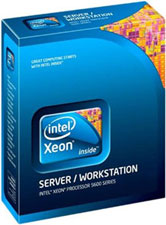
I've configured and built a number of dual processor Xeon 56xx series workstations in the past, yet each time destined for a fairly mundane existence doing computational modeling or some other serious business. Each time I'm finished, there's a brief but overwhelming temptation to install Crysis, Metro 2033—heck, something!—with all the eye candy on max with a 2560x1600 display. Each time, I shake that thought away right after finishing burn-in testing as I pop in the latest version of whatever *nix flavor is appropriate. I kid myself that maybe eventually I'll be able to build something like this without having to justify every bit of it as being vitally critical for modeling complicated scientific something or other. Anyway, if you've got nearly limitless piles of sweet cash lying around, this is the rig for you.
Starting out is really the motherboard. Initially, I wanted to go with a server-class motherboard, the SupermicroMBD-X8DTi, having worked with it and similar workstation boards in the past. If you want a dual CPU motherboard, the options basically dictate either a similar class of "server" motherboard like theMBD-X8DTi from Supermicro, something comparable from Tyan, or the only choice in the more conventional desktop class of products, the EVGA Classified SR-2. TheMBD-X8DTi and SR-2 are actually quite similar; both are built around the Intel 5520 and ICH10R chipsets, both are happy with an unreasonable number of triple 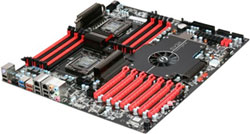 channel ECC or non-ECC DDR3-1333 memory, and both actually present similar PCI-E lane configurations. The Supermicro comes with onboard graphics, but we'd obviously recommend disabling that in the BIOS and forgetting about it. The Supermicro board costs $430, whereas the Classified SR-2 costs a slightly mind-bending $590. The difference between the two is ultimately whether you want SLI licensing so you can stick in some some multi-GPU goodness from NVIDIA. Remember that NVIDIA still requires either a BIOS key or NVIDIA bridge chip for SLI to work, both of which the cheaper Supermicro board lacks. AMD CrossFire remains feasible on both, but that difference, along with the more enthusiast-oriented features like overclocking support, ultimately led me to settle on the SR-2, despite its nose-bleed-inducing price tag.
channel ECC or non-ECC DDR3-1333 memory, and both actually present similar PCI-E lane configurations. The Supermicro comes with onboard graphics, but we'd obviously recommend disabling that in the BIOS and forgetting about it. The Supermicro board costs $430, whereas the Classified SR-2 costs a slightly mind-bending $590. The difference between the two is ultimately whether you want SLI licensing so you can stick in some some multi-GPU goodness from NVIDIA. Remember that NVIDIA still requires either a BIOS key or NVIDIA bridge chip for SLI to work, both of which the cheaper Supermicro board lacks. AMD CrossFire remains feasible on both, but that difference, along with the more enthusiast-oriented features like overclocking support, ultimately led me to settle on the SR-2, despite its nose-bleed-inducing price tag.
Of course, now that we've incurred such a large price premium to get a two-socket motherboard, we should stick in at least a couple hex-core CPUs, right? Two 6-core CPUs with Hyper-Threading gives a whopping 24 threads of power. For that, there's Intel Westmere—the SR-2 andMBX-X8DTi both support Xeon 5500 and 5600 series. At the most extreme, there's the 3.33GHz Xeon 5680, which runs $1725, but anyone can sort by price and see what's the most expensive, and we're still at least somewhat interested in performance per buck (or are we?) The Xeon 5680 can Turbo from 3.33GHz to 3.6GHz. Subjectively, the Xeon X5660 seems to be a better tradeoff between price and stock clock speed at 2.8GHz, plus you get a larger turbo boost up to 3.2GHz. Either way, the two CPUs will set you back a big chunk of change. As one reader pointed out, you also need a heatsink for Xeon, as it doesn't ship with one, so we grabbed a couple of Xigmatek Dark-Knight coolers.
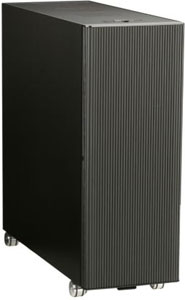
In the traditional workstation configuration, I usually opt for a Cooler Master Cosmos or Cosmos S, and when I think about what's really ultimate in the case market these days, my mind immediately settles on either the iconic Thermaltake Level 10 or the ABS Canyon 695. TheMBD-X8DTi and other workstation boards are E-ATX, which would fit in all the aforementioned cases but the Level 10. Unfortunately, the SR-2 is enormous and necessitated EVGA to define their own motherboard form factor entirely—HPTX—which is a mind-numbing 13.6" x 15". The result is that our case recommendation is limited unless you're willing to go custom or break out the Dremel. Luckily, there's a line of HPTX cases by Lian Li that are attractive and fit the SR-2 just fine. If you're opposed to finding a motherboard tray properly machined for HPTX or loath to do modifications yourself, the Lian Li PC-V2120X is what you should go for.
Moving along we come to the GPUs; I talked with Ryan on this to get his input, and ultimately we both agreed on 2xSLI GTX 580s. EVGA is (at time of this writing) offering the Superclocked version at 797MHz core/1594MHz shader clocks for prices on par with the competition's regularly clocked GTX 580s. The choice is simple at that point: go for the factory overclocked EVGA while it's still feasible.
Storage on a dream build would be incomplete without an SSD for the OS. Thankfully, the RevoDrive X2 is indeed bootable and thus makes an ideal drive for the OS and critical system apps. On every system I've built in recent memory, I've gone with an SSD + RAID array of slow but capacious storage; I think the same is best here. Get four or five 1.5TB or higher HDDs of whatever brand makes you feel warmest inside, toss them in a RAID5 set, and enjoy a crap-ton of storage that's fully redundant. I suppose if you're really feeling ultimate, you could get a RAID card instead of using the ICH10R's software fakeRAID, but it probably isn't critical unless you want to eek out everything you can from those mechanical drives.
My dream PC would be incomplete without at least 12GB of RAM—it's just that simple. I think it's safe to say that 6GB is pretty standard for midrange X58 gaming builds, with 8GB and 12GB starting to become the norm at the fringes. To stay safely ahead, you've got to move to 24GB, which is actually surprisingly common for workstations processing huge datasets that need to exist entirely in RAM. Of course, it's more than likely that no game will ever make use of the 24GB, but we're building the ultimate system here, right? The objective is to play Crysis within Crysis if we could. I settled on two sets of matched Patriot 12GB (3x4GB) kits, as all the 24GB (3x8GB) kits I could find were either sold out or lacked heat spreaders. You should still get triple-channel performance on either the SupermicroMBD-X8DTi or EVGA SR-2 with six populated memory slots, but it definitely makes me a little uneasy populating so many if you don't have lots of airflow.
For the power supply, we're big fans of the Antec TPQ-1200 Silver, which packs a half and half modular/fixed set of cables. It's a combination that provides the best of both worlds for not blocking airflow with unused power cables, and fixed cables for being absolutely certain connectors aren't a concern. The TPQ-1200 is (as the name implies) 1200W, which should be adequate for the SR-2, two Xeons, and two GTX 580s, plus all those mechanical drives.
I'm a fan of LG's 10x Blu-ray burner with LightScribe support, purely because it's SATA, well received, and I've built a number of systems with it in the past. You get DVD+/-R support at 16x, and CDR support at 48x, which is pretty standard. I'm a sucker for LightScribe support just because I always convince myself that the next batch of writeable disks I buy will also be LightScribe; sadly, I've somehow avoided ever doing it. Regardless, the optical drive is quickly becoming marginalized, but for your ultimate build, why not include one? Same thing with the sound card—you don't really need one anymore if onboard audio suffices, but if we're going for the ultimate, you might as well consider it.
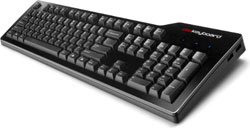
Since we're going all out, we'd be remiss if we didn't include suggestions for the peripherals as well. When I think of the ultimate keyboard, I immediately think of one keyboard—the Das Keyboard. If you haven't heard of it, chances are you've been living under a rock, or been blind sighted by all the flashy gaming-focused keyboards with copious amounts of LED lights but little attention to the mechanics of keydomes. If you want a gaming keyboard, get the Logitech G510—it's awesome and I have one—but if you're serious about typing, consider the Das Keyboard. Das Keyboard is essentially the modern IBM model M equivalent, and is a joy to type on purely because of the serious mechanical and aural feedback. For the mouse, I'm a huge fan of Razer. I worked my way from the Logitech MX1000 (the first laser mouse) through a number of Logitech and Razer mice alike, but keep settling back down on Razer. It's ultimately a matter of personal taste.
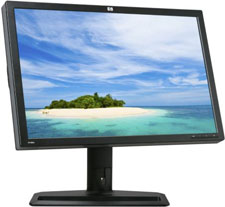
Last but certainly not least is the monitor. The choices here are quite obvious: either buy a 30" Dell U3011 or its archrival, the HP ZR30w. Both are IPS, both look superb, and both round out the dream configuration. Or maybe you need two 30-inchers? I've left out a fan recommendation since the stock fans for these Xeons have (thus far) seemed sufficient, but the usual Zalman 120mm or similar are always an option I'd encourage.
This configuration is again insane, but at the end of it all, I still find myself thoroughly convinced that if I had infinite monies, I'd put it together in a heartbeat—and maybe even splurge for that 3.33GHz Xeon 5680, regardless of the fact that it's overkill even for Crysis. If you had infinite cash or an appetite for the drooling-on-the-carpet insane—and need it right stinkin' now—this is the system I'd recommend, right after I note that Sandy Bridge is right around the corner. If this configuration is financially justifiable to you, by all means, do it! (And send us some benchmarks and pictures!) Alas, for me, it's still little more than a holiday dream.










112 Comments
View All Comments
StormyParis - Friday, November 19, 2010 - link
htpc should fit into a stereo cabinet. you're trying to build a NAS + HTPC + desktop into one machine, which makes no sense at all. Split the thing in 3, with a real, small, silent HTPC, a NAS, and a mini-itx desktop, and you're much better off, for pretty much the same price.ajlueke - Friday, November 19, 2010 - link
While it is somewhat a matter of personal preference, I admit, some people really hate giant cases in the living room. I love having everything built into one system, and using it to serve the rest of the house and play Starcraft II on the big screen. The real downside, is then you are using a high end rig to serve you other computers as opposed to a NAS, and a NAS is going to have far superior numbers in the power consumption department.Mathieu Bourgie - Friday, November 19, 2010 - link
Good job on the builds everyone, great idea of getting several members of the AT's team to work together on this.Here are my opinions, suggestions and things that I'd personally change:
Dustin's AMD Pure Budget System:
Hard Drive: Actually, if you shop on Amazon instead, you can snap a Spinpoint F3 500Gb for about $46 and a 1TB for $53, without needing to find any coupons.
Power Supply: I'd mention that the Antec EarthWatts Green EA-380D 380W doesn't include a power cord in its package. Not a big deal for most of us, but still good to knowi f you don't have a spare cord.
DVD Burner: Why go with an IDE based model, which is out of stock by the way? Because the motherboard comes with a single SATA and a single IDE cable? Hardly a reason if you ask me.
Might as well get a SATA model that can be used for years and years, if you upgrade the system down the road. Going by customer's feedback on NewEgg, ASUS 24x SATA DVD Burner is one of the most reliable model available, for only $20: http://www.newegg.com/Product/Product.aspx?Item=N8...
Balraj's Intel Budget System:
The one stick of RAM is an interesting trade off, sure you lose dual-channel but you gain the ability to easily upgrade RAM down the road. Then again, a motherboard with 4 RAM slots would allow for both options.
Blu-Ray: The Samsung SH-B083L/BSBP has pretty bad reviews on NewEgg, I'd get the Samsung SH-B123L instead, which costs $20 more, but is also faster (12x vs 8x).
Power Supply: I cannot skip this: you really want to avoid using a low-end, generic power supply, for reliability purposes and to protect your components. You do not want to cut corners on a power supply.
Jarred's AMD Budget Gaming System:
You mention Crossfire support, but go with a motherboard that has the PCI-Express 16x slots running at 16x and 4x, which would bottleneck performance?
For a similar price, the ASRock 870 EXTREME3 comes with two PCI-Express 16x slots at 8x/8x, which are well spaced to allow both cards to "breath".
125W CPU, with a stock cooler? Sure, it's "adequate" for cooling in most cases, but that stock cooler is going to be heard from miles away when you game for hours and/or during hot summer nights if you don't have an AC. Not much of an issue if you play with headphones, but still, I'd get at least a Cooler Master Hyper 212 Plus CPU Cooler.
"Gaming depends primarily on your GPU" "You could even go with a cheaper CPU like the Athlon II X4 645 or the Phenom II X4 810"
Agreed for most games, but there are games that will be CPU bound (Think RTS like SC2, or MMORPG like WoW), where you'll want a powerful CPU that allow the GPU to flex its muscles.
Also, while the X4 645 isn't a bad CPU, losing the L3 cache and the lower frequencies are going to hurt performance quite a bit for video games.
Vivek's Midrange Intel System:
Once again, Crossfire is mentioned, but the second PCI-Express slot runs at 4x...
An ASRock P55 EXTREME4 will fix that and if you want USB 3.0 and SATA 6.0Gb/s at the same time as Crossfire 8x/8x, you'll want an ASUS P7P55D-E Pro, which features a PLX chip, making it one of the few P55 boards that can run SATA 6.0Gb/s, USB 3.0 and Crossfire 8x/8x all at once, unlike most boards where USB 3.0 and SATA 6.0Gb/s will fall back to USB 2.0 and SATA 3.0Gb/s due to the lack of bandwidth (lack of PCI-Express lanes, thanks to the P55 chipset).
PSU: OCZ don't exactly make the most reliable PSUs, with the biggest issue being that reliability varies from a model to another, since they use various manufacturers for their PSUs. You get what you pay for with a PSU and a solid Corsair or Seasonic PSU will serve you much better IMO.
Raja's Midrange AMD Overclocking System:
I actually agree with all your choices and like how you didn't strictly stick to NewEgg. Way to go.
Raja's Midrange Intel Overclocking System:
I'd avoid the ASUS Maximus III GENE like the plague. I used to recommend it, until I'd hear back from so many readers that had issues with it (Read some review on NewEgg) that I had no choice but to stop recommending it, because it's so unreliable.
Ryan's High-End Gaming System:
Way to go for keeping noise somewhat under control. Once again though, an IDE DVD Burner in a 2k+ system? Really?
Also, the sound card is priced at $100, not $75, unless I missed something here.
Brian's Intel Dream PC:
Hahaha, now you're talking! Couldn't agree more on the motherboard, which is a one of a kind.
Just one thing though: You forgot CPU Coolers, since Xeon CPUs don't come with any.
Also, why ECC RAM? ECC seems kind of futile for a Gaming PC.
Keyboard: Yes! Mechanical keyboards are the best. I personally recently got a Filco with MX Cherry Blue switches and that keyboard helped me increase my WPM typing speed tremendously. The feedback and noise is also great for gaming.
Mouse: I've always been a fan of the Logitech MX-518, which remains excellent years after its release and offers a great bang for your buck too.
Don't have much to add to the HTPCs, they make sense and quite frankly, it's a matter of personal tastes too.
Except for a few things mentioned above, great job all on the builds. Although I'm a bit sadden to not have seen any Workstation build.
P.S. For those who wonder about my experience building PCs and the like, I’m a computer enthusiast with 10 years of experience in building, fixing and modifying computers, who has been writing about/offering PC Builds of all kinds (Gaming, HTPC, Workstations, etc.) at various price points on my own blog (www.hardware-revolution.com) for over two years and a half now.
Cheers,
Mathieu
Ben90 - Friday, November 19, 2010 - link
I agree completely on the inclusion of a mechanical keyboard, they are the SSDs of the keyboard world. Once you try to type on rubber domes again it feels absolutely horrible.Personally I am a Cherry Black guy as I like the linear travel for gaming, but for typing its impossible to beat Cherry Blues unless quietness is a metric.
bji - Friday, November 19, 2010 - link
How do you feel about scissor switch keyboards? I like them as I find them to be much less mushy than rubber dome keyboards, but alot quieter and with less key travel than mechanical keyboards. I use the Kensington "Slim Type Keyboard" (that's what it says on the bottom, I can't remember the exact model number) and highly recommend it.Tom_S - Friday, November 19, 2010 - link
Concerning keyboards etc. I *have* been living under a rock and had not heard of the DAS keyboard that sounds interesting, but while under the rock I have been using my Northgate and Avant keyboards (made by CVT Inc) which were always the gold standard in mechanical keyboards. I looked at the site, and it appears that the lesser of the Avant kbds is not available right now, but the Stellar is.http://www.cvtinc.com/products/keyboards/menu.htm
I concede that these are old fashioned - not USB without an adapter, no USB hub, but they have been around since the 1980's and are noteworthy. To further date myself, one of their features has been to remap the left ctrl and caps lock keys (moving ctrl next to the "a" key), for those of us still used to old terminals and editors/programming environments that use control keys.
strikeback03 - Friday, November 19, 2010 - link
Are the current Samsung HDDs any good? A couple years ago I bought a Samsung HDD recommended on this site for a build for work. First one wouldn't allow an OS install. RMAed it, got a replacement. That one died a few months later. RMAed that, bought one from another brand, and after testing the third Samsung to be sure it could be formatted when we got it just kept it on the side for emergency use. Can't say I'm anxious to try again.Mathieu Bourgie - Friday, November 19, 2010 - link
Samsung HDDs are some of the best drives on the market in my opinion. Their F3 and F4 (The 7,200 rpm 320GB model that is) line-up offer some of the best throughputs rates in MB/s, are very reliable and emit very little heat.For the average latency time, the Western Digital drives tend to be better, although they run hotter and have slightly lower reliability. For Gaming, I'd say that WD drives are the best, but quite frankly, you wouldn't be able to tell the difference between a system equipped with Samsung or WD drives.
Also, keep in mind warranty: W.D. offers 5 years on their Black Caviar line-up, as opposed to 3 years on their Caviar Blue and 3 years for Samsung drives.
JarredWalton - Friday, November 19, 2010 - link
I did try to price-check everything using our internal pricing tools (Dynamite-Data is an AnandTech affiliate of sorts), so where I could find clearly better prices from other than Newegg I went that route. Obviously, 10 systems or whatever makes it a bit difficult to get every little detail, which is why some IDE DVDRW drives slipped in. Oops!The CrossFire/SLI issue on lower end motherboards (i.e. P55 with x16/x4) was another one that I wracked my brain on for a good long time. I'd really like to go the Biostar route on Vivek's setup (or the overclocking board), but truthfully I'm a bit gun-shy with Biostar. I've had decent boards in the past from them, and other boards that sucked hard. Price is another item that I kept running into -- I don't want to recommend an expensive Intel board when SB is coming so soon.
I'll try to go through and update the optical drives to be SATA, though. Shame on my fellow writers for being so lazy! :-) Thanks for the comments.
JarredWalton - Friday, November 19, 2010 - link
Okay, I made some updates and added some additional commentary where appropriate. But I chose to disagree (or let the editors disagree at least) with some of your comments. IMO, there's no need for aftermarket cooling on CPUs if you don't intend to overclock, so I left my build without one.The other big issue is Newegg reviews; they're just not reliable by any stretch. We've had motherboards that our guys loved that get mediocre scores at Newegg because of idiot users. "Gee... my memory isn't working and I plugged it in, never looked at the BIOS, never updated the BIOS. What's wrong with this board!?" Likewise, some items get 5 eggs not because they're the best but because a lot of buyers think they're a great value... and they wouldn't know quality if it walked up and punched them in the nose. So, while I generally avoid stuff that gets 3 eggs or less, the 4/5 egg stuff may be decent, good, or great depending on the user. Plus, people with problems are about 10X more likely to post as people where everything worked fine.
Anyway, thanks for the corrections/suggestions.